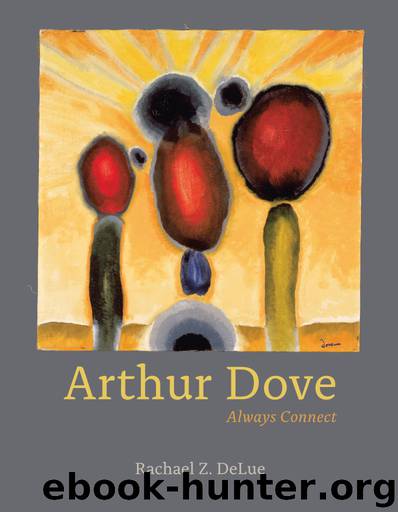Arthur Dove by Rachael Z. DeLue

Author:Rachael Z. DeLue [DeLue, Rachael Z.]
Language: eng
Format: epub
ISBN: 9780226281230
Publisher: University of Chicago Press
Published: 2016-01-21T16:00:00+00:00
Other Sounds
In comparison to the record and radio paintings, Dove’s attempt in Fog Horns (1929) to visualize the idea of sound appears relatively straightforward, closer in effect to the sonic registrations of Sentimental Music (figs. 4, 106). Tonal gradations of purple and plum fashion four circular forms, lighter at the edges, darker at the center, that march with surety across the canvas’s horizontal span. The effect produced is one of looking into the bells of a row of brass instruments, as if Dove meant to make most literal the idea of a foghorn. It is also one of sound approaching a listener, or a listener approaching a sound, such that what began as a faint hum winds up as a roaring blare. Perhaps Dove meant to render this particular acoustic phenomenon, named after the Austrian mathematician and physicist Christian Doppler, who first described it in 1842. Called, of course, the “Doppler effect,” it involves an apparent change in the frequency and wavelength of a wave that is perceived by an observer moving relative to the source of the wave, which explains what one hears as the waxing and waning of a sound (of a siren of a fire engine or ambulance, for instance) as it approaches and then moves on. The concentric bands, originating in a deep purple-black and lightening in hue as they spread outward, diagram the illusion of transforming sound in a manner analogous to similar circle forms in Moon (fig. 5) that visualize the idea of a lunar phase, a process of waxing and waning undetectable by the naked eye. In Fog Horns, the implied distance between the three large concentric circle motifs and the much smaller one at right further articulates the idea of sound traveling in space and seeming to transmute along the way. What to do with Dove’s evocation here of sonic transfiguration despite the fact that the hearing of foghorn sound is not usually subject to the Doppler effect remains an open question. It could be that his attribution to foghorn sound of a set of properties not usually associated with such an acoustic phenomenon was meant to press the painting past the realm of the straightforward and the empirically accessible and closer toward the terrain of telepathy and tunks.
Dove’s Fog Horns also begs the question of synesthesia, in which a stimulus usually perceived by one sense presents to and stimulates another, as when a person perceives a color when he or she hears a particular sound—especially because synesthetic experience embodies the effects of interconnection and serial substitution that preoccupied Dove. Yet one would be hard pressed to find evidence for an engagement on Dove’s part with this phenomenon and its interlocutors in the period, and his pictures in the end do not really support the association.111 Rather, in a painting like Fog Horns Dove brings together three major fixations—weather, the sea, and sound—thus intimating the connections he would draw among the three in his record and radio paintings. Because a foghorn is
Download
This site does not store any files on its server. We only index and link to content provided by other sites. Please contact the content providers to delete copyright contents if any and email us, we'll remove relevant links or contents immediately.
The Secret History by Donna Tartt(18163)
Red Sparrow by Jason Matthews(5197)
Harry Potter 02 & The Chamber Of Secrets (Illustrated) by J.K. Rowling(3556)
In a Sunburned Country by Bill Bryson(3368)
Drawing Cutting Edge Anatomy by Christopher Hart(3290)
Figure Drawing for Artists by Steve Huston(3272)
The Daily Stoic by Holiday Ryan & Hanselman Stephen(3110)
Harry Potter and the Prisoner of Azkaban (Book 3) by J. K. Rowling(3109)
Japanese Design by Patricia J. Graham(3001)
The Roots of Romanticism (Second Edition) by Berlin Isaiah Hardy Henry Gray John(2820)
Make Comics Like the Pros by Greg Pak(2758)
Stacked Decks by The Rotenberg Collection(2687)
Harry Potter and the Deathly Hallows (7) by J.K. Rowling(2550)
Draw-A-Saurus by James Silvani(2504)
Tattoo Art by Doralba Picerno(2488)
On Photography by Susan Sontag(2482)
Foreign Devils on the Silk Road: The Search for the Lost Treasures of Central Asia by Peter Hopkirk(2388)
Churchill by Paul Johnson(2364)
The Daily Stoic by Ryan Holiday & Stephen Hanselman(2344)
